air condition MITSUBISHI LANCER 2005 Owner's Manual
[x] Cancel search | Manufacturer: MITSUBISHI, Model Year: 2005, Model line: LANCER, Model: MITSUBISHI LANCER 2005Pages: 788, PDF Size: 45.98 MB
Page 178 of 788
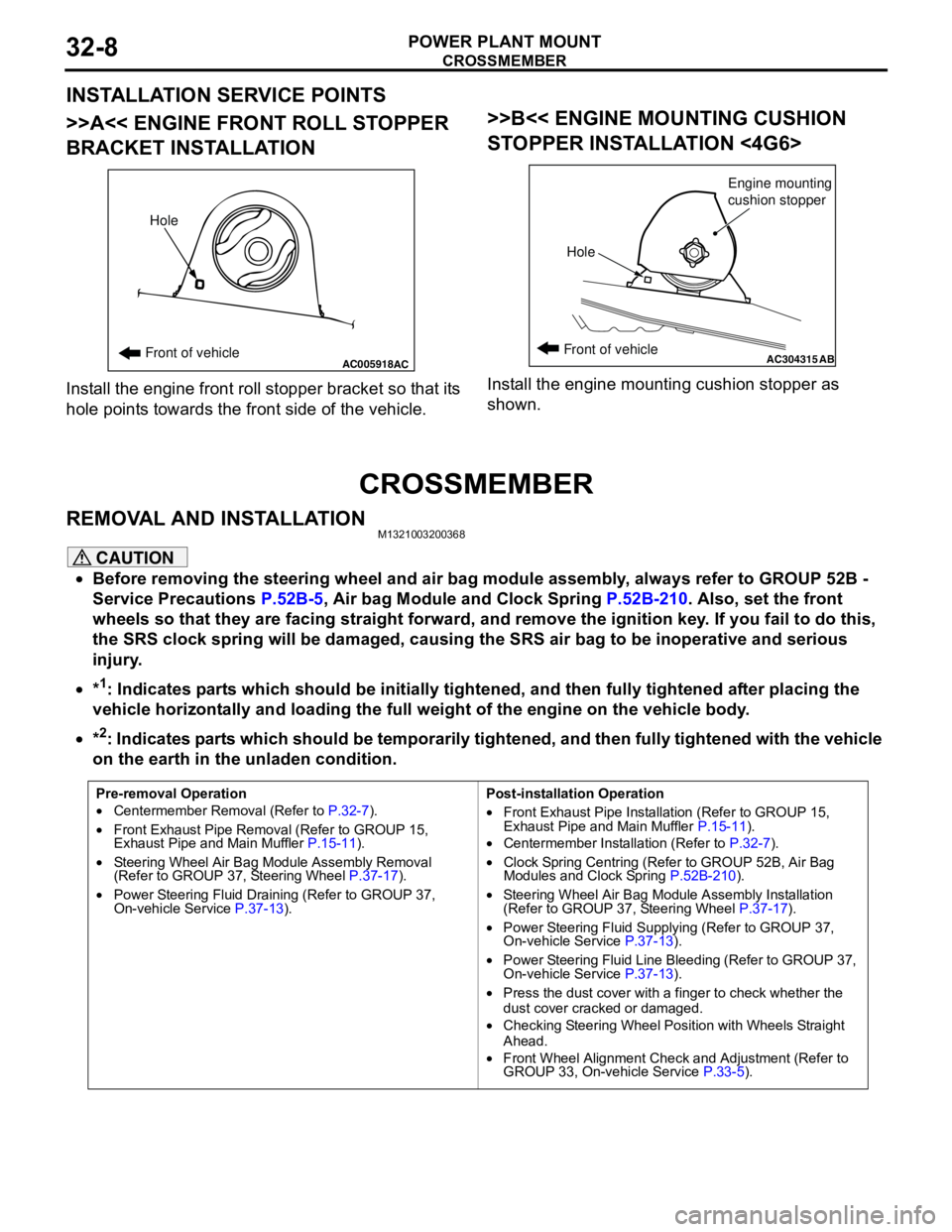
CROSSMEMBER
POWER PLANT MOUNT32-8
INSTALLATION SERVICE POINTS
>>A<< ENGINE FRONT ROLL STOPPER
BRACKET INSTALLATION
Install the engine front roll stopper bracket so that its
hole points towards the front side of the vehicle.
>>B<< ENGINE MOUNTING CUSHION
STOPPER INSTALLATION <4G6>
Install the engine mounting cushion stopper as
shown.
CROSSMEMBER
REMOVAL AND INSTALLATIONM1321003200368
CAUTION
•Before removing the steering wheel and air bag module assembly, always refer to GROUP 52B -
Service Precautions P.52B-5, Air bag Module and Clock Spring P.52B-210. Also, set the front
wheels so that they are facing straight forward, and remove the ignition key. If you fail to do this,
the SRS clock spring will be damaged, causing the SRS air bag to be inoperative and serious
injury.
•*
1: Indicates parts which should be initially tightened, and then fully tightened after placing the
vehicle horizontally and loading the full weight of the engine on the vehicle body.
•*
2: Indicates parts which should be temporarily tightened, and then fully tightened with the vehicle
on the earth in the unladen condition.
AC005918Front of vehicleHoleACAC304315ABFront of vehicle
HoleEngine mounting
cushion stopper
Pre-removal Operation
•Centermember Removal (Refer to P.32-7).
•Front Exhaust Pipe Removal (Refer to GROUP 15,
Exhaust Pipe and Main Muffler P.15-11).
•Steering Wheel Air Bag Module Assembly Removal
(Refer to GROUP 37, Steering Wheel P.37-17).
•Power Steering Fluid Draining (Refer to GROUP 37,
On-vehicle Service P.37-13).Post-installation Operation
•Front Exhaust Pipe Installation (Refer to GROUP 15,
Exhaust Pipe and Main Muffler P.15-11).
•Centermember Installation (Refer to P.32-7).
•Clock Spring Centring (Refer to GROUP 52B, Air Bag
Modules and Clock Spring P.52B-210).
•Steering Wheel Air Bag Module Assembly Installation
(Refer to GROUP 37, Steering Wheel P.37-17).
•Power Steering Fluid Supplying (Refer to GROUP 37,
On-vehicle Service P.37-13).
•Power Steering Fluid Line Bleeding (Refer to GROUP 37,
On-vehicle Service P.37-13).
•Press the dust cover with a finger to check whether the
dust cover cracked or damaged.
•Checking Steering Wheel Position with Wheels Straight
Ahead.
•Front Wheel Alignment Check and Adjustment (Refer to
GROUP 33, On-vehicle Service P.33-5).
Page 248 of 788
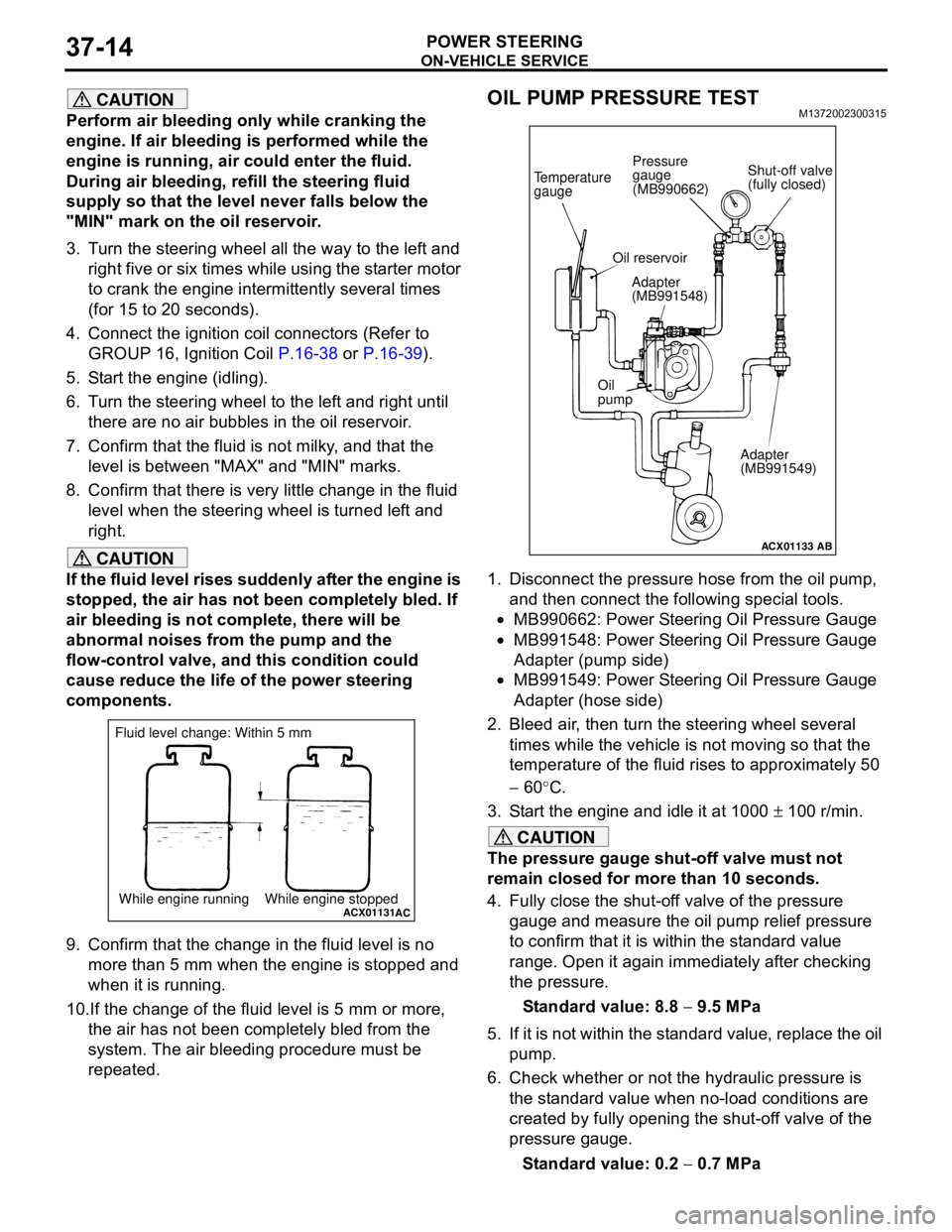
ON-VEHICLE SERVICE
POWER STEERING37-14
CAUTION
Perform air bleeding only while cranking the
engine. If air bleeding is performed while the
engine is running, air could enter the fluid.
During air bleeding, refill the steering fluid
supply so that the level never falls below the
"MIN" mark on the oil reservoir.
3. Turn the steering wheel all the way to the left and
right five or six times while using the starter motor
to crank the engine intermittently several times
(for 15 to 20 seconds).
4. Connect the ignition coil connectors (Refer to
GROUP 16, Ignition Coil P.16-38 or P.16-39).
5. Start the engine (idling).
6. Turn the steering wheel to the left and right until
there are no air bubbles in the oil reservoir.
7. Confirm that the fluid is not milky, and that the
level is between "MAX" and "MIN" marks.
8. Confirm that there is very little change in the fluid
level when the steering wheel is turned left and
right.
CAUTION
If the fluid level rises suddenly after the engine is
stopped, the air has not been completely bled. If
air bleeding is not complete, there will be
abnormal noises from the pump and the
flow-control valve, and this condition could
cause reduce the life of the power steering
components.
9. Confirm that the change in the fluid level is no
more than 5 mm when the engine is stopped and
when it is running.
10.If the change of the fluid level is 5 mm or more,
the air has not been completely bled from the
system. The air bleeding procedure must be
repeated.
OIL PUMP PRESSURE TESTM1372002300315
1. Disconnect the pressure hose from the oil pump,
and then connect the following special tools.
•MB990662: Power Steering Oil Pressure Gauge
•MB991548: Power Steering Oil Pressure Gauge
Adapter (pump side)
•MB991549: Power Steering Oil Pressure Gauge
Adapter (hose side)
2. Bleed air, then turn the steering wheel several
times while the vehicle is not moving so that the
temperature of the fluid rises to approximately 50
− 60°C.
3. Start the engine and idle it at 1000 ± 100 r/min.
CAUTION
The pressure gauge shut-off valve must not
remain closed for more than 10 seconds.
4. Fully close the shut-off valve of the pressure
gauge and measure the oil pump relief pressure
to confirm that it is within the standard value
range. Open it again immediately after checking
the pressure.
Standard value: 8.8 − 9.5 MPa
5. If it is not within the standard value, replace the oil
pump.
6. Check whether or not the hydraulic pressure is
the standard value when no-load conditions are
created by fully opening the shut-off valve of the
pressure gauge.
Standard value: 0.2 − 0.7 MPa
ACX01131While engine running While engine stoppedAC
Fluid level change: Within 5 mm
ACX01133
Temperature
gauge
Oil reservoir
Adapter
(MB991548)
Oil
pump
Adapter
(MB991549)
AB
Shut-off valve
(fully closed) Pressure
gauge
(MB990662)
Page 306 of 788
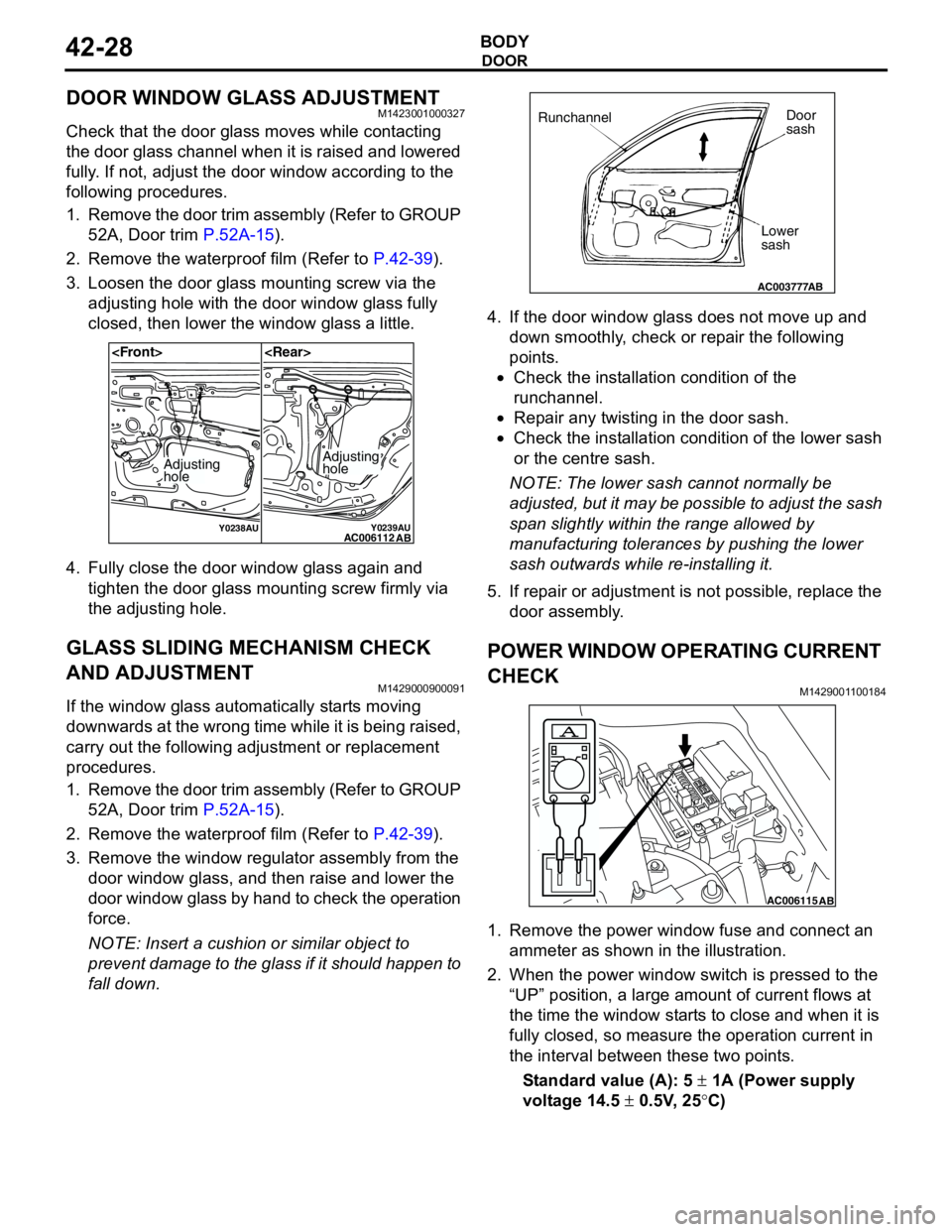
DOOR
BODY42-28
DOOR WINDOW GLASS ADJUSTMENTM1423001000327
Check that the door glass moves while contacting
the door glass channel when it is raised and lowered
fully. If not, adjust the door window according to the
following procedures.
1. Remove the door trim assembly (Refer to GROUP
52A, Door trim P.52A-15).
2. Remove the waterproof film (Refer to P.42-39).
3. Loosen the door glass mounting screw via the
adjusting hole with the door window glass fully
closed, then lower the window glass a little.
4. Fully close the door window glass again and
tighten the door glass mounting screw firmly via
the adjusting hole.
GLASS SLIDING MECHANISM CHECK
AND ADJUSTMENT
M1429000900091
If the window glass automatically starts moving
downwards at the wrong time while it is being raised,
carry out the following adjustment or replacement
procedures.
1. Remove the door trim assembly (Refer to GROUP
52A, Door trim P.52A-15).
2. Remove the waterproof film (Refer to P.42-39).
3. Remove the window regulator assembly from the
door window glass, and then raise and lower the
door window glass by hand to check the operation
force.
NOTE: Insert a cushion or similar object to
prevent damage to the glass if it should happen to
fall down.4. If the door window glass does not move up and
down smoothly, check or repair the following
points.
•Check the installation condition of the
runchannel.
•Repair any twisting in the door sash.
•Check the installation condition of the lower sash
or the centre sash.
NOTE: The lower sash cannot normally be
adjusted, but it may be possible to adjust the sash
span slightly within the range allowed by
manufacturing tolerances by pushing the lower
sash outwards while re-installing it.
5. If repair or adjustment is not possible, replace the
door assembly.
POWER WINDOW OPERATING CURRENT
CHECK
M1429001100184
1. Remove the power window fuse and connect an
ammeter as shown in the illustration.
2. When the power window switch is pressed to the
“UP” position, a large amount of current flows at
the time the window starts to close and when it is
fully closed, so measure the operation current in
the interval between these two points.
Standard value (A): 5 ± 1A (Power supply
voltage 14.5 ± 0.5V, 25°C)
Y0238AUY0239AUAC006112
AB
Adjusting
holeAdjusting
hole
AC003777
RunchannelDoor
sash
Lower
sash
AB
AC006115AB
Page 378 of 788
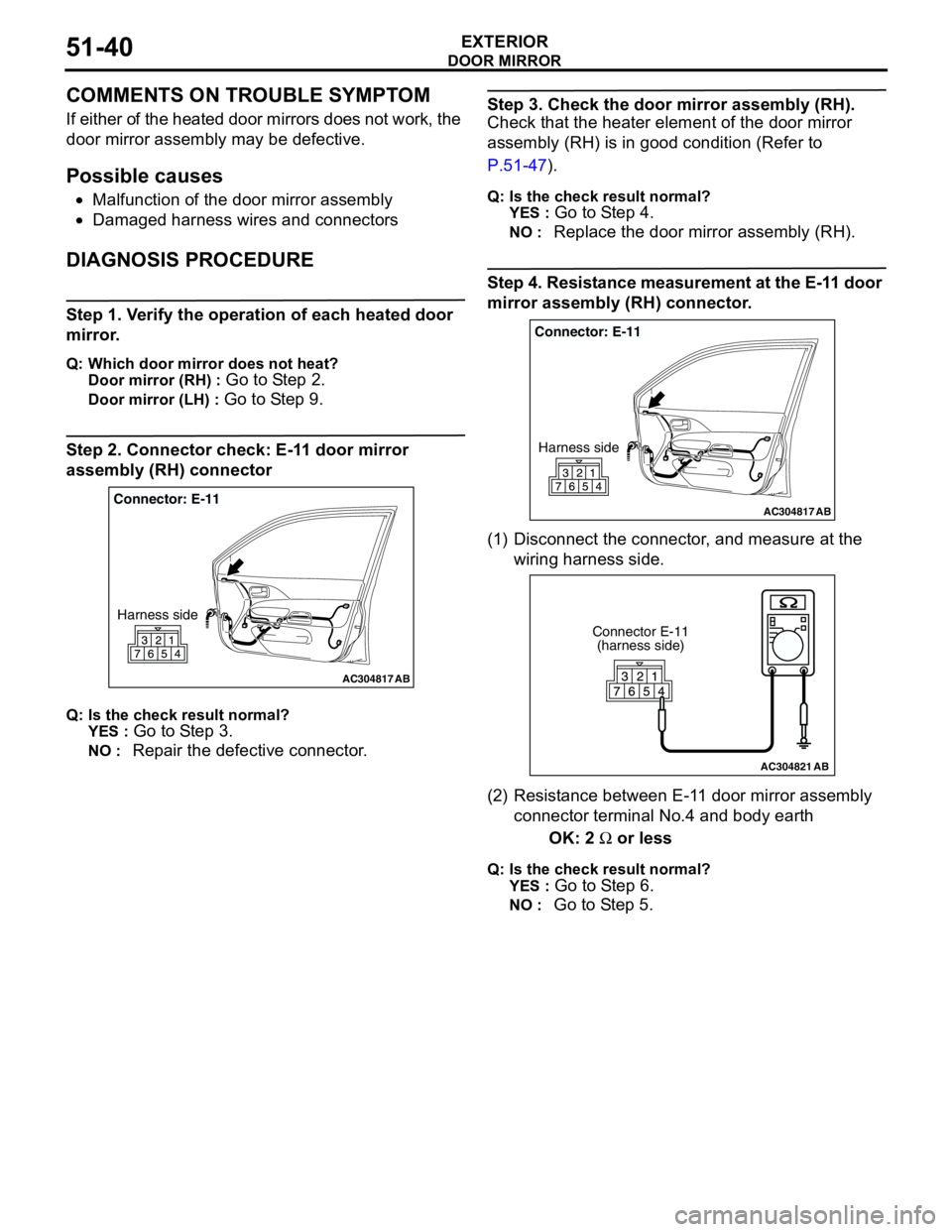
DOOR MIRROR
EXTERIOR51-40
COMMENTS ON TROUBLE SYMPTOM
If either of the heated door mirrors does not work, the
door mirror assembly may be defective.
Possible causes
•Malfunction of the door mirror assembly
•Damaged harness wires and connectors
DIAGNOSIS PROCEDURE
Step 1. Verify the operation of each heated door
mirror.
Q: Which door mirror does not heat?
Door mirror (RH) :
Go to Step 2.
Door mirror (LH) : Go to Step 9.
Step 2. Connector check: E-11 door mirror
assembly (RH) connector
Q: Is the check result normal?
YES :
Go to Step 3.
NO : Repair the defective connector.
Step 3. Check the door mirror assembly (RH).
Check that the heater element of the door mirror
assembly (RH) is in good condition (Refer to
P.51-47).
Q: Is the check result normal?
YES :
Go to Step 4.
NO : Replace the door mirror assembly (RH).
Step 4. Resistance measurement at the E-11 door
mirror assembly (RH) connector.
(1) Disconnect the connector, and measure at the
wiring harness side.
(2) Resistance between E-11 door mirror assembly
connector terminal No.4 and body earth
OK: 2 Ω or less
Q: Is the check result normal?
YES :
Go to Step 6.
NO : Go to Step 5.
AC304817
Connector: E-11
Harness side
AB
AC304817
Connector: E-11
Harness side
AB
AC304821
Connector E-11
(harness side)
AB
Page 380 of 788
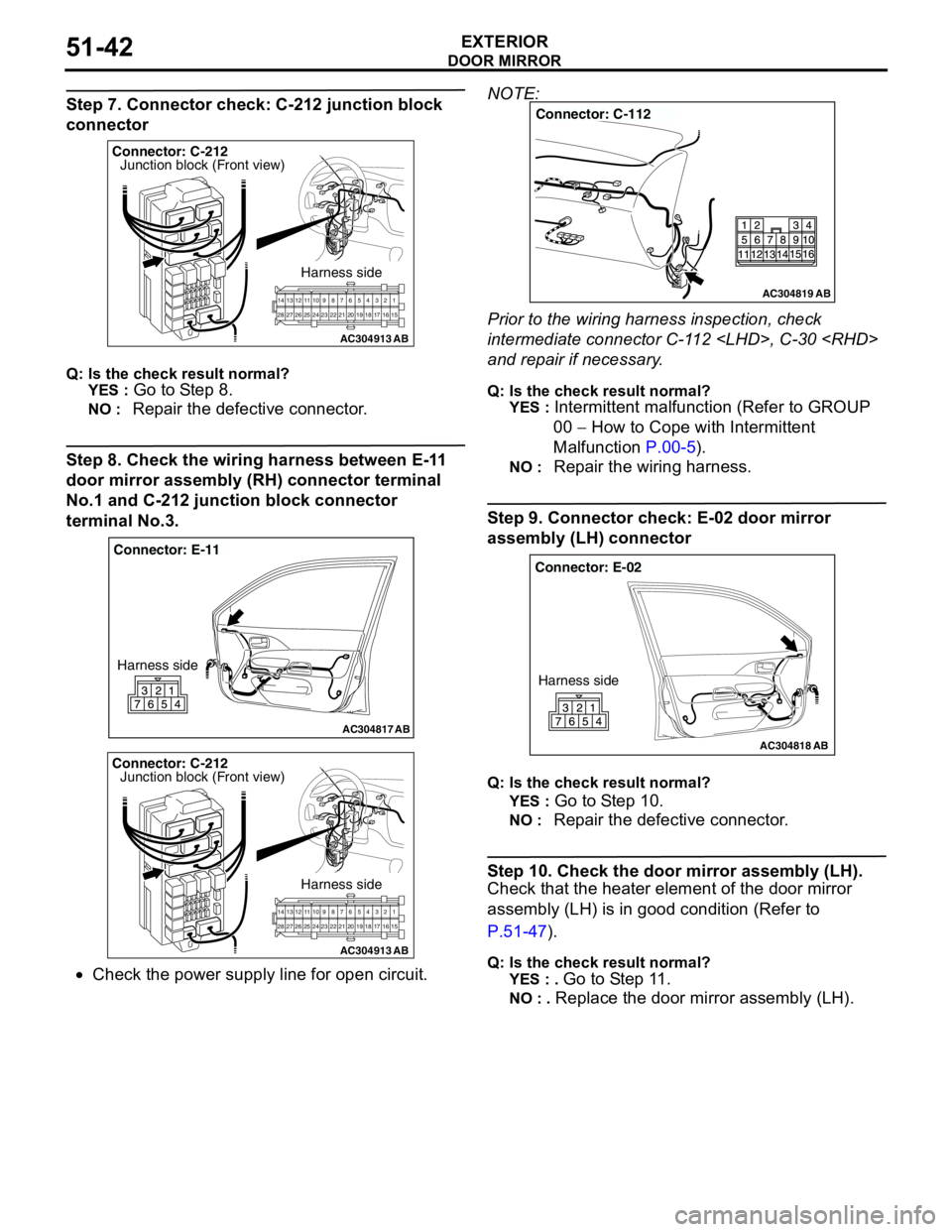
DOOR MIRROR
EXTERIOR51-42
Step 7. Connector check: C-212 junction block
connector
Q: Is the check result normal?
YES :
Go to Step 8.
NO : Repair the defective connector.
Step 8. Check the wiring harness between E-11
door mirror assembly (RH) connector terminal
No.1 and C-212 junction block connector
terminal No.3.
•Check the power supply line for open circuit.NOTE:
Prior to the wiring harness inspection, check
intermediate connector C-112
and repair if necessary.
Q: Is the check result normal?
YES :
Intermittent malfunction (Refer to GROUP
00 − How to Cope with Intermittent
Malfunction P.00-5).
NO : Repair the wiring harness.
Step 9. Connector check: E-02 door mirror
assembly (LH) connector
Q: Is the check result normal?
YES :
Go to Step 10.
NO : Repair the defective connector.
Step 10. Check the door mirror assembly (LH).
Check that the heater element of the door mirror
assembly (LH) is in good condition (Refer to
P.51-47).
Q: Is the check result normal?
YES : .
Go to Step 11.
NO : . Replace the door mirror assembly (LH).
AC304913
21716151718 201912345 623 222425282627981011141213
Connector: C-212
Harness side
AB
Junction block (Front view)
AC304817
Connector: E-11
Harness side
AB
AC304913
21716151718 201912345 623 222425282627981011141213
Connector: C-212
Harness side
AB
Junction block (Front view)
AC304819
Connector: C-112
AB
AC304818
Connector: E-02
Harness side
AB
Page 399 of 788
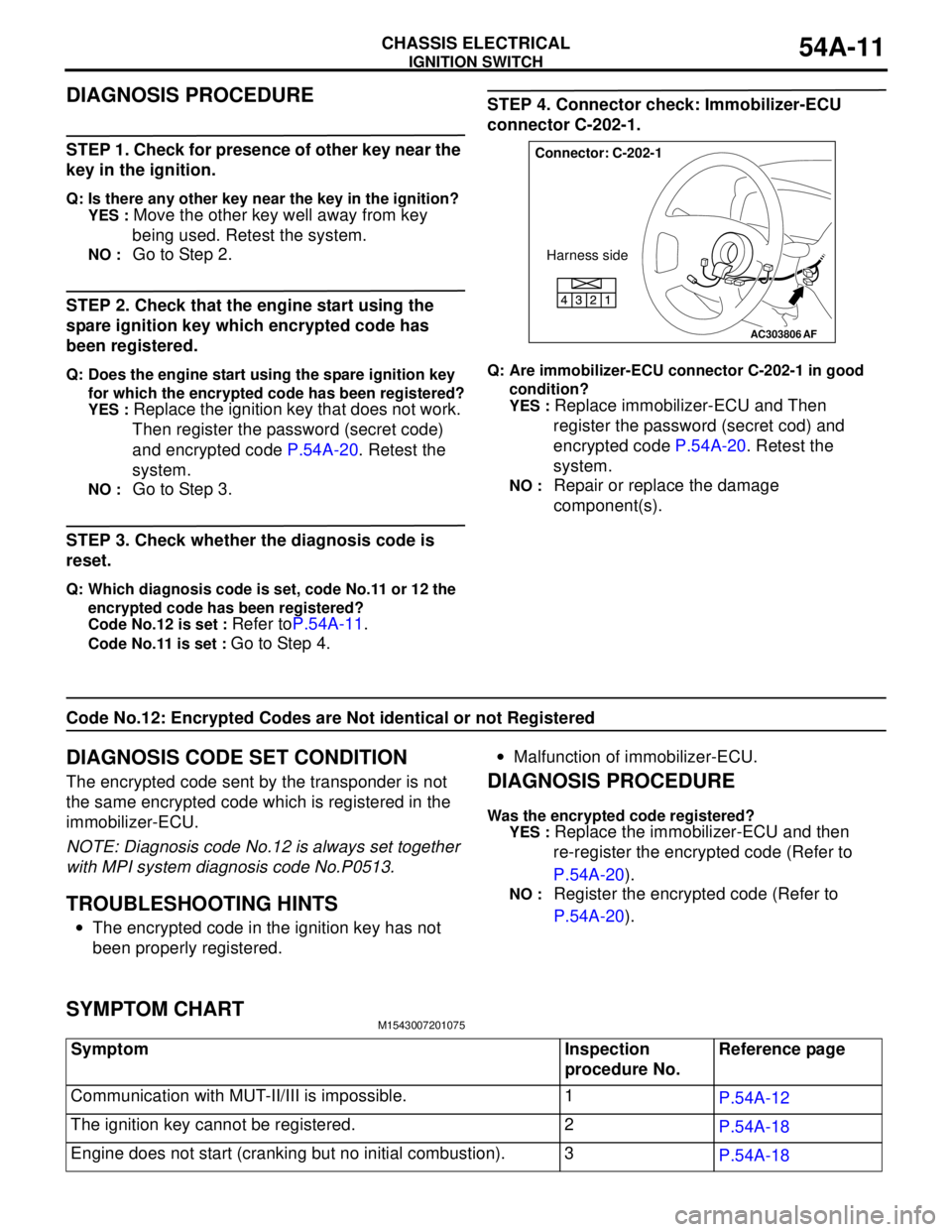
IGNITION SWITCH
CHASSIS ELECTRICAL54A-11
DIAGNOSIS PROCEDURE
STEP 1. Check for presence of other key near the
key in the ignition.
Q: Is there any other key near the key in the ignition?
YES :
Move the other key well away from key
being used. Retest the system.
NO : Go to Step 2.
STEP 2. Check that the engine start using the
spare ignition key which encrypted code has
been registered.
Q: Does the engine start using the spare ignition key
for which the encrypted code has been registered?
YES :
Replace the ignition key that does not work.
Then register the password (secret code)
and encrypted code P.54A-20. Retest the
system.
NO : Go to Step 3.
STEP 3. Check whether the diagnosis code is
reset.
Q: Which diagnosis code is set, code No.11 or 12 the
encrypted code has been registered?
Code No.12 is set :
Refer toP.54A-11.
Code No.11 is set : Go to Step 4.
STEP 4. Connector check: Immobilizer-ECU
connector C-202-1.
Q: Are immobilizer-ECU connector C-202-1 in good
condition?
YES :
Replace immobilizer-ECU and Then
register the password (secret cod) and
encrypted code P.54A-20. Retest the
system.
NO : Repair or replace the damage
component(s).
Code No.12: Encrypted Codes are Not identical or not Registered
DIAGNOSIS CODE SET CONDITION
The encrypted code sent by the transponder is not
the same encrypted code which is registered in the
immobilizer-ECU.
NOTE: Diagnosis code No.12 is always set together
with MPI system diagnosis code No.P0513.
TROUBLESHOOTING HINTS
•The encrypted code in the ignition key has not
been properly registered.•Malfunction of immobilizer-ECU.
DIAGNOSIS PROCEDURE
Was the encrypted code registered?
YES :
Replace the immobilizer-ECU and then
re-register the encrypted code (Refer to
P.54A-20).
NO : Register the encrypted code (Refer to
P.54A-20).
SYMPTOM CHARTM1543007201075
AC303806
Connector: C-202-1
Harness side
AF
Symptom Inspection
procedure No.Reference page
Communication with MUT-II/III is impossible. 1
P.54A-12
The ignition key cannot be registered. 2
P.54A-18
Engine does not start (cranking but no initial combustion). 3
P.54A-18
Page 401 of 788
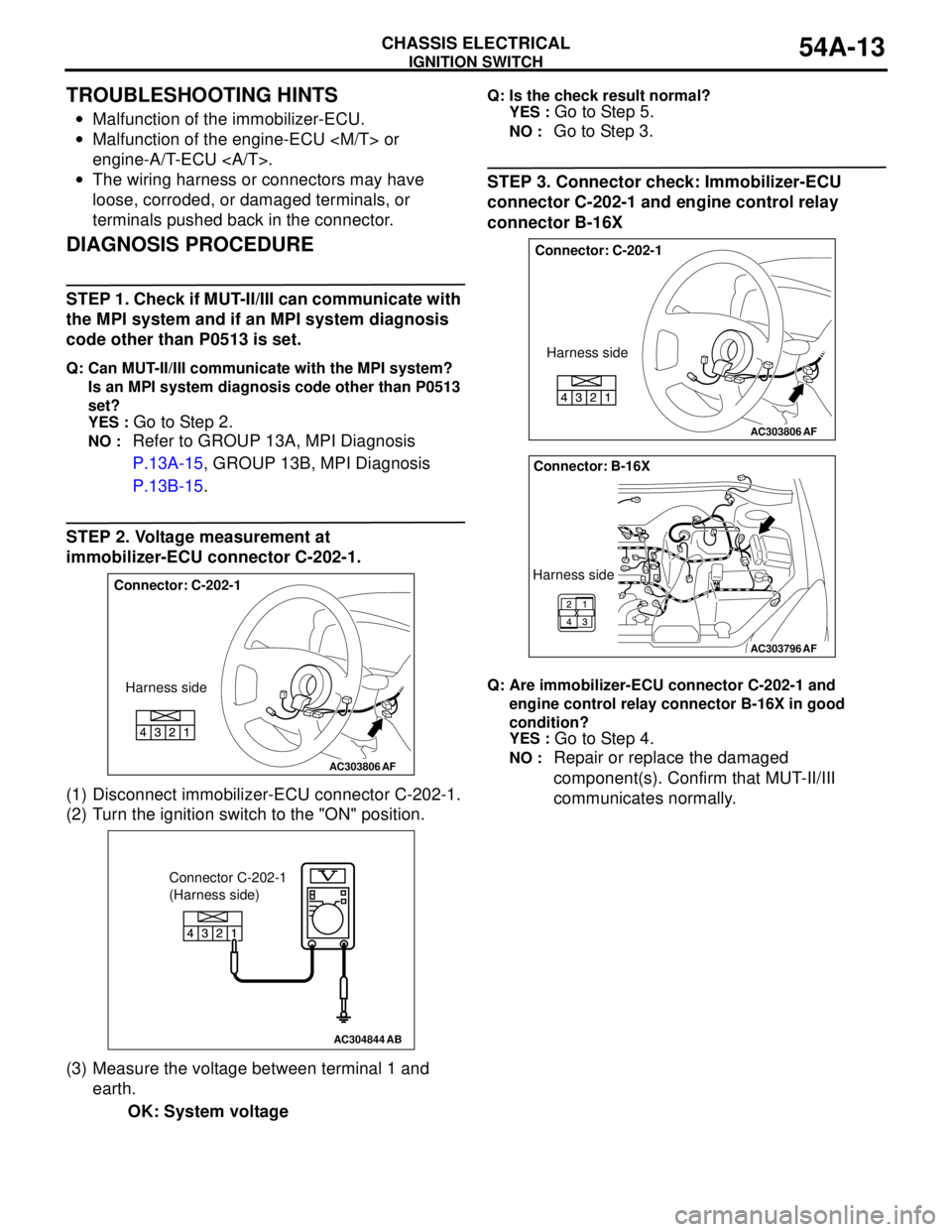
IGNITION SWITCH
CHASSIS ELECTRICAL54A-13
TROUBLESHOOTING HINTS
•Malfunction of the immobilizer-ECU.
•Malfunction of the engine-ECU
engine-A/T-ECU .
•The wiring harness or connectors may have
loose, corroded, or damaged terminals, or
terminals pushed back in the connector.
DIAGNOSIS PROCEDURE
STEP 1. Check if MUT-II/III can communicate with
the MPI system and if an MPI system diagnosis
code other than P0513 is set.
Q: Can MUT-II/III communicate with the MPI system?
Is an MPI system diagnosis code other than P0513
set?
YES :
Go to Step 2.
NO : Refer to GROUP 13A, MPI Diagnosis
P.13A-15, GROUP 13B, MPI Diagnosis
P.13B-15.
STEP 2. Voltage measurement at
immobilizer-ECU connector C-202-1.
(1) Disconnect immobilizer-ECU connector C-202-1.
(2) Turn the ignition switch to the "ON" position.
(3) Measure the voltage between terminal 1 and
earth.
OK: System voltage
Q: Is the check result normal?
YES :
Go to Step 5.
NO : Go to Step 3.
STEP 3. Connector check: Immobilizer-ECU
connector C-202-1 and engine control relay
connector B-16X
Q: Are immobilizer-ECU connector C-202-1 and
engine control relay connector B-16X in good
condition?
YES :
Go to Step 4.
NO : Repair or replace the damaged
component(s). Confirm that MUT-II/III
communicates normally.AC303806
Connector: C-202-1
Harness side
AF
AC304844AB
Connector C-202-1
(Harness side)
AC303806
Connector: C-202-1
Harness side
AF
AC303796
Connector: B-16X
Harness side
AF
Page 402 of 788
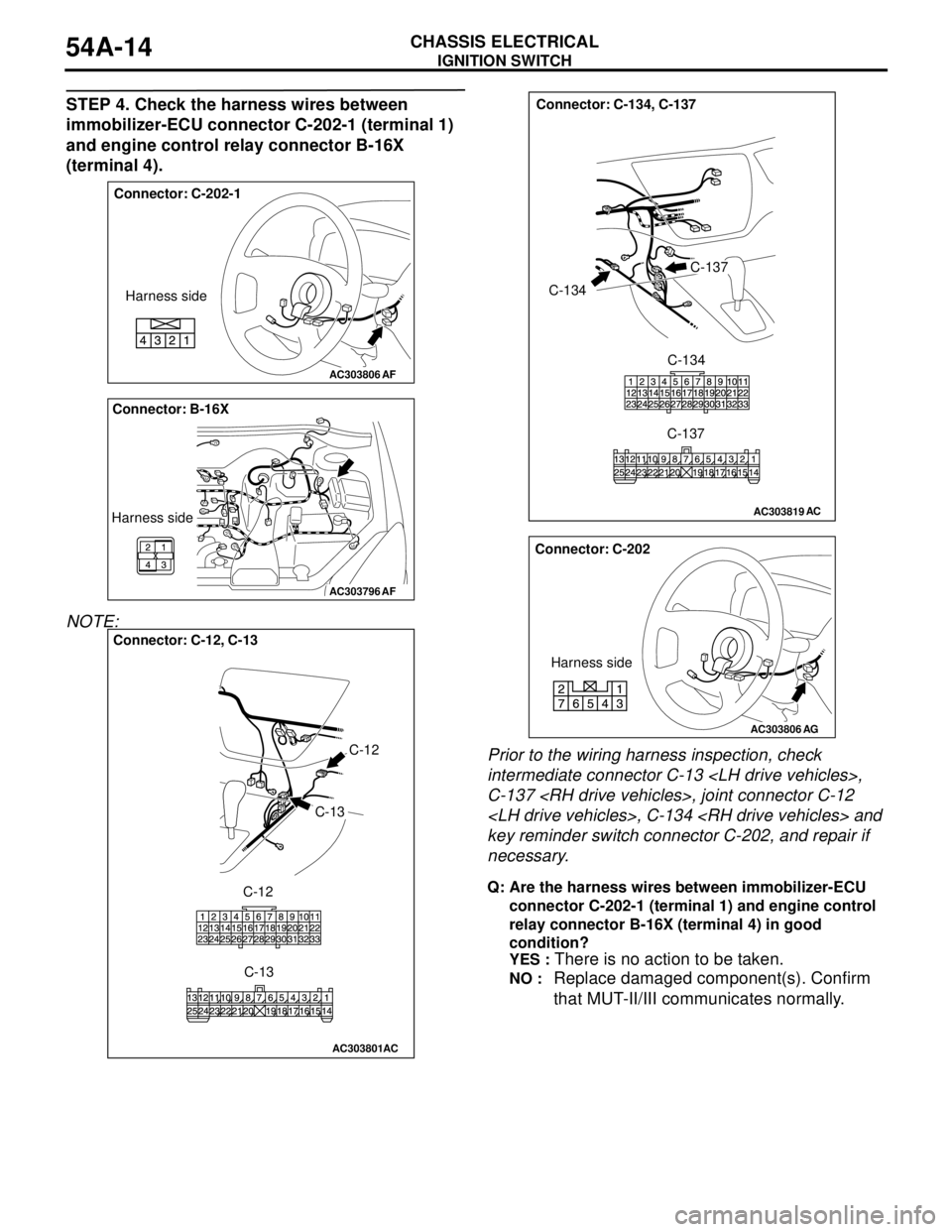
IGNITION SWITCH
CHASSIS ELECTRICAL54A-14
STEP 4. Check the harness wires between
immobilizer-ECU connector C-202-1 (terminal 1)
and engine control relay connector B-16X
(terminal 4).
NOTE:
Prior to the wiring harness inspection, check
intermediate connector C-13
C-137
key reminder switch connector C-202, and repair if
necessary.
Q: Are the harness wires between immobilizer-ECU
connector C-202-1 (terminal 1) and engine control
relay connector B-16X (terminal 4) in good
condition?
YES :
There is no action to be taken.
NO : Replace damaged component(s). Confirm
that MUT-II/III communicates normally.
AC303806
Connector: C-202-1
Harness side
AF
AC303796
Connector: B-16X
Harness side
AF
AC303801
Connector: C-12, C-13
C-12
C-13
C-12
C-13
AC
AC303819
Connector: C-134, C-137
C-134
C-137
C-134
C-137
AC
AC303806
Connector: C-202
Harness side
AG
Page 403 of 788
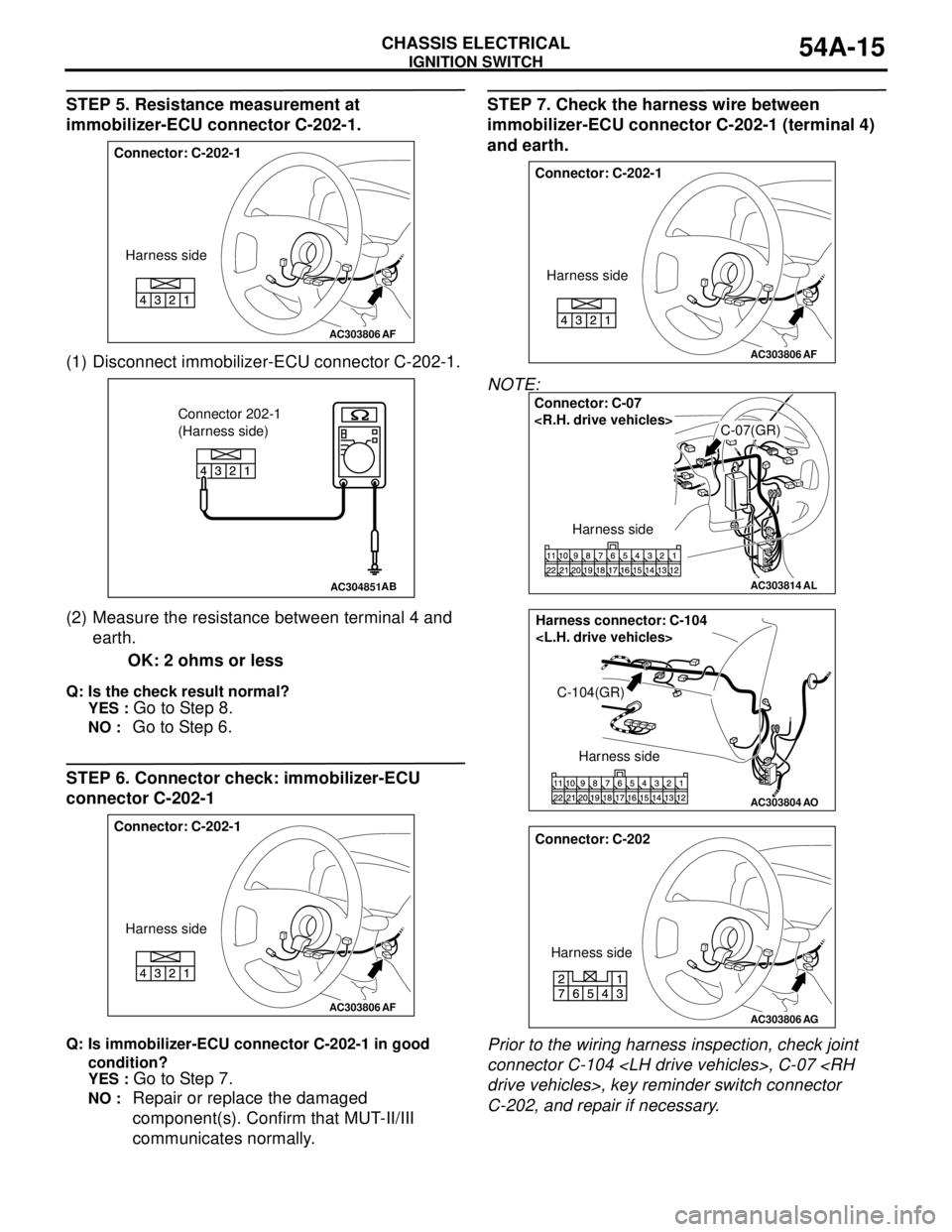
IGNITION SWITCH
CHASSIS ELECTRICAL54A-15
STEP 5. Resistance measurement at
immobilizer-ECU connector C-202-1.
(1) Disconnect immobilizer-ECU connector C-202-1.
(2) Measure the resistance between terminal 4 and
earth.
OK: 2 ohms or less
Q: Is the check result normal?
YES :
Go to Step 8.
NO : Go to Step 6.
STEP 6. Connector check: immobilizer-ECU
connector C-202-1
Q: Is immobilizer-ECU connector C-202-1 in good
condition?
YES :
Go to Step 7.
NO : Repair or replace the damaged
component(s). Confirm that MUT-II/III
communicates normally.
STEP 7. Check the harness wire between
immobilizer-ECU connector C-202-1 (terminal 4)
and earth.
NOTE:
Prior to the wiring harness inspection, check joint
connector C-104
C-202, and repair if necessary.
AC303806
Connector: C-202-1
Harness side
AF
AC304851AB
Connector 202-1
(Harness side)
AC303806
Connector: C-202-1
Harness side
AF
AC303806
Connector: C-202-1
Harness side
AF
AC303814
Connector: C-07
C-07(GR)
Harness side
AL
AC303804AO
Harness connector: C-104
C-104(GR)
Harness side
AC303806
Connector: C-202
Harness side
AG
Page 404 of 788
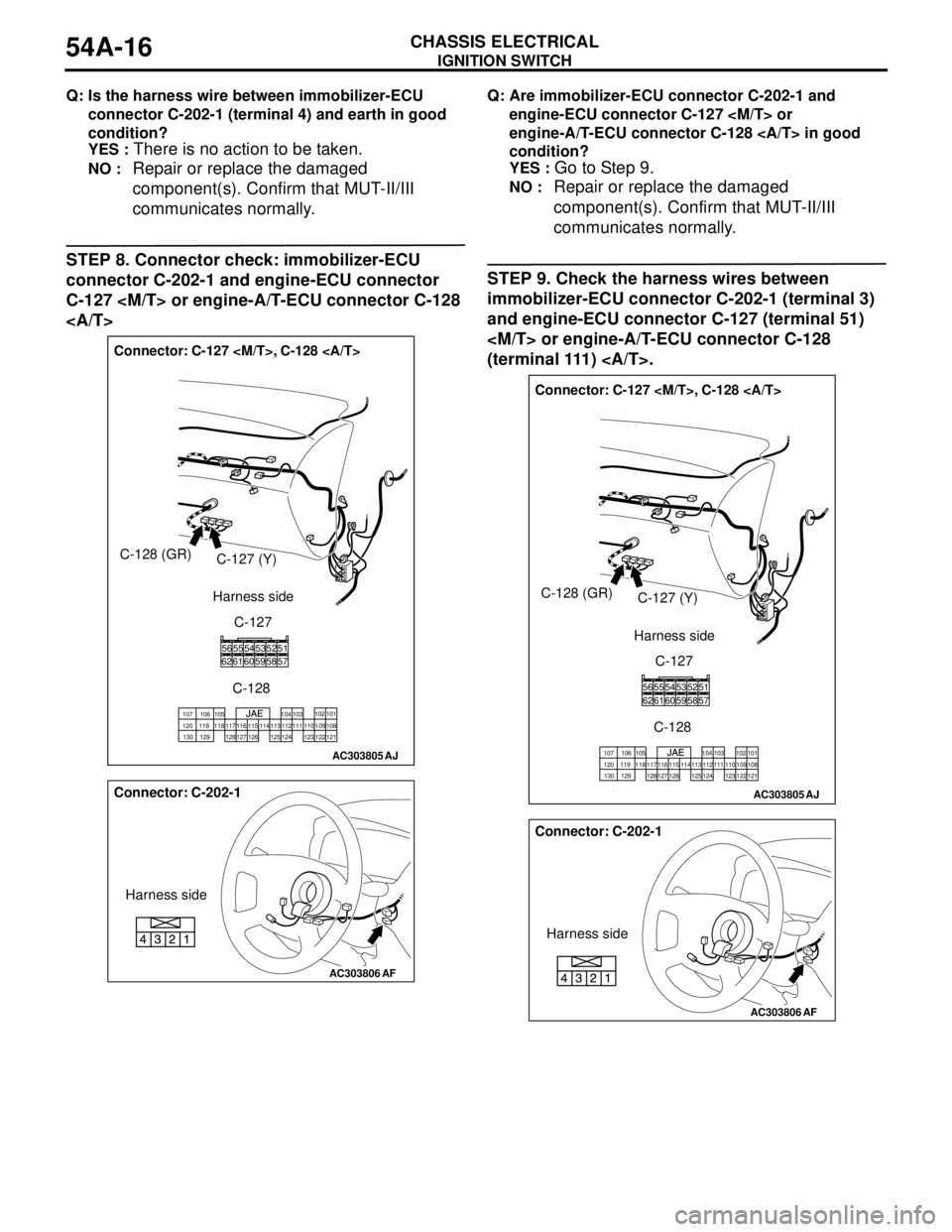
IGNITION SWITCH
CHASSIS ELECTRICAL54A-16
Q: Is the harness wire between immobilizer-ECU
connector C-202-1 (terminal 4) and earth in good
condition?
YES :
There is no action to be taken.
NO : Repair or replace the damaged
component(s). Confirm that MUT-II/III
communicates normally.
STEP 8. Connector check: immobilizer-ECU
connector C-202-1 and engine-ECU connector
C-127
Q: Are immobilizer-ECU connector C-202-1 and
engine-ECU connector C-127
engine-A/T-ECU connector C-128 in good
condition?
YES :
Go to Step 9.
NO : Repair or replace the damaged
component(s). Confirm that MUT-II/III
communicates normally.
STEP 9. Check the harness wires between
immobilizer-ECU connector C-202-1 (terminal 3)
and engine-ECU connector C-127 (terminal 51)
(terminal 111) .
AC303805
Connector: C-127
C-128 (GR)
C-127 (Y)
C-127
C-128
585261556256605459535751
101 102
103 104 105 106 107
120 119 118 117 116 115 114 113 112 111 110 109 108
121 122 123 124 125 126 127 128 129 130
Harness side
AJ
AC303806
Connector: C-202-1
Harness side
AF
AC303805
Connector: C-127
C-128 (GR)
C-127 (Y)
C-127
C-128
585261556256605459535751
101 102
103 104 105 106 107
120 119 118 117 116 115 114 113 112 111 110 109 108
121 122 123 124 125 126 127 128 129 130
Harness side
AJ
AC303806
Connector: C-202-1
Harness side
AF